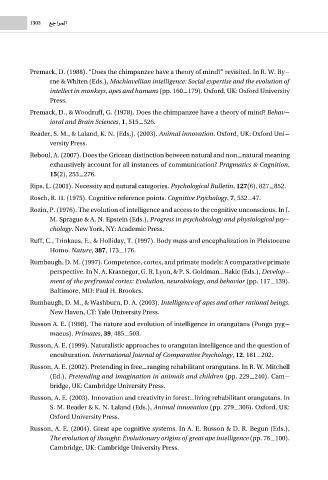Page 1304 - theCambridgehandbookofintelligence1
P. 1304
1303 ™LGôªdG
Premack, D. (1988). “Does the chimpanzee have a theory of mind?” revisited. In R. W. By-
rne & Whiten (Eds.), Machiavellian intelligence: Social expertise and the evolution of
intellect in monkeys, apes and humans (pp. 160-179). Oxford, UK: Oxford University
Press.
Premack, D., & Woodruff, G. (1978). Does the chimpanzee have a theory of mind? Behav-
ioral and Brain Sciences, 1, 515-526.
Reader, S. M., & Laland, K. N. (Eds.). (2003). Animal innovation. Oxford, UK: Oxford Uni-
versity Press.
Reboul, A. (2007). Does the Gricean distinction between natural and non-natural meaning
exhaustively account for all instances of communication? Pragmatics & Cognition,
15(2), 253-276.
Rips, L. (2001). Necessity and natural categories. Psychological Bulletin, 127(6), 827-852.
Rosch, R. H. (1975). Cognitive reference points. Cognitive Psychology, 7, 532-47.
Rozin, P. (1976). The evolution of intelligence and access to the cognitive unconscious. In J.
M. Sprague & A. N. Epstein (Eds.), Progress in psychobiology and physiological psy-
chology. New York, NY: Academic Press.
Ruff, C., Trinkaus, E., & Holliday, T. (1997). Body mass and encephalization in Pleistocene
Homo. Nature, 387, 173-176.
Rumbaugh, D. M. (1997). Competence, cortex, and primate models: A comparative primate
perspective. In N. A. Krasnegor, G. R. Lyon, & P. S. Goldman-Rakic (Eds.), Develop-
ment of the prefrontal cortex: Evolution, neurobiology, and behavior (pp. 117-139).
Baltimore, MD: Paul H. Brookes.
Rumbaugh, D. M., & Washburn, D. A. (2003). Intelligence of apes and other rational beings.
New Haven, CT: Yale University Press.
Russon A. E. (1998). The nature and evolution of intelligence in orangutans (Pongo pyg-
maeus). Primates, 39, 485-503.
Russon, A. E. (1999). Naturalistic approaches to orangutan intelligence and the question of
enculturation. International Journal of Comparative Psychology, 12, 181-202.
Russon, A. E. (2002). Pretending in free-ranging rehabilitant orangutans. In R. W. Mitchell
(Ed.), Pretending and imagination in animals and children (pp. 229-240). Cam-
bridge, UK: Cambridge University Press.
Russon, A. E. (2003). Innovation and creativity in forest-living rehabilitant orangutans. In
S. M. Reader & K. N. Laland (Eds.), Animal innovation (pp. 279-306). Oxford, UK:
Oxford University Press.
Russon, A. E. (2004). Great ape cognitive systems. In A. E. Russon & D. R. Begun (Eds.),
The evolution of thought: Evolutionary origins of great ape intelligence (pp. 76-100).
Cambridge, UK: Cambridge University Press.

